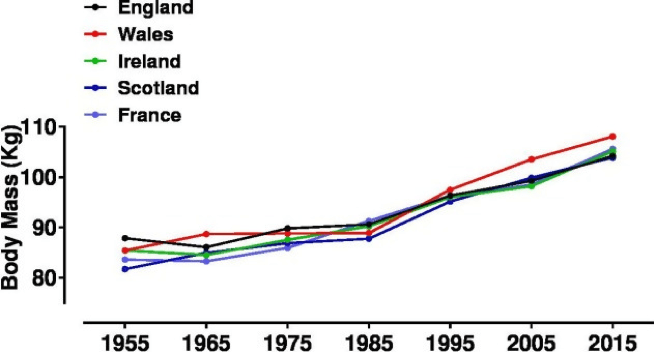Rugby has come a very long way since 1830 when, at Rugby school in England, a soccer player called William Web Ellis allegedly picked up the ball and ran with it clutched under his arm. What started as a little more than a playground prank became a recognized sport in 1845 when the first official code of rules was written.
Initially played by teams of 20 players, rugby quickly grew into an internationally played sport, albeit an amateur one. That all changed when the game split into two codes – rugby league and rugby union.
Rugby league was, at the time, the professional branch of the game, with its own rule variations. Rugby union continued as an amateur sport until 1995 when the International Rugby Board declared Rugby Union to be an ‘open’ professional sport.
During its history, rugby has evolved enormously. Rule changes have made the game safer and more flowing with fewer stoppages. This makes the game more enjoyable for players and spectators alike.
However, the most apparent changes in rugby are not the rules or the equipment, but the size and shape of the players. Modern-day ruggers are giants compared to the payers of old.
This is not just conjecture. An interesting study conducted by several departments at Imperial College, London, has revealed just how much ruggers have changed since the 1950s.
In the study, the body mass and height of players representing their countries in the first game of the Five Nations in 1955, 1965, 1975, 1985 and 1995 and, for 2005 and 2015, the Six Nations, were collected from gameday souvenir programs. In 1955, the average player’s body mass was 84.8 kg. In contrast, in 2015, that had risen to 105.4 kg – an increase of 24.3%. Most players from the 1950s would be dwarfed by their modern counterparts.

Take a look at this classic rugby game from 1972 – Wales vs. the New Zealand All-Blacks. It’s clear that both sides were extremely skillful, but the players are obviously much smaller than most of today’s ruggers. Modern backs are significantly bigger than yesterday’s forwards.
What has happened to ruggers over the last 60 or so years? Why are today’s amateur and professional players bigger than their predecessors? We have some theories…!
The Second World War
The second World War lasted from 1939 to 1945. During that time, millions of men between the ages of 16-40 fought and died for their respective countries. The war effort meant that the world lost many of its fittest, strongest men. This not only affected rugby players in the 1950s but also had a knock-on effect during the 1960s and 1970s. In simple terms, the gene pool took a hit, and it took several decades to recover.
Improvements in nutrition
The Second World War might have ended in 1945, but its global impact was felt for the next decade or more. In the UK, food was rationed until July 1954 – a full nine years after the end of the war.
Meat and other staples were in very short supply and, as a result, many families had to get by on considerably less food than they do now. Lack of food meant people tended to be smaller and lighter.
Sports nutrition was also unheard of at this time. While post-war nutrition was based on whole foods, and processed foods were yet to appear on grocery store shelves, very little was known about how to eat for better performance or muscle growth. Supplements were all-but unheard of.
As the 1970s become the 1980s, sports nutrition became more recognized and influential. Players started to eat to support their rugby training, and that led to increases in lean mass.
Training advances
Sports science is a relatively new field. During the 1950s to the 1970s, training for sport was very hit or miss. Strength training for increased muscle size and improved performance was all-but unheard of. Most rugby coaches believed that lifting weights would make players slow and muscle bound. Looking at some rugby players from that bygone era, it would be hard to identify them as ruggers. In contrast, modern ruggers as usually very easy to spot.
Fast forward to the modern era, and even most amateur players know that hitting the gym is a good idea. The internet means that today’s players know more about fitness and strength training than most early rugby coaches. And speaking of coaches, most modern teams have dedicated strength and conditioning experts whereas, in the good old days, there was one coach plus an assistant or two for the entire team. Resources like Ruck Science have also helped players learn about the intricacies of training for rugby, and that includes building functional muscle mass.
Interestingly, the biggest increase in player body mass happened in the decade after the game went professional. Before the advent of professionalism, even top-flight international players had to hold down a full-time job. In many instances, players were provided jobs by their rugby club, but they still had to work.
A full-time job meant that time to train was limited, as was recovery. In contrast, modern professionals can eat, sleep, and breathe rugby. More quality training and more-than-adequate recovery means greater muscle mass.
Improvements in selection
While rugby has long been a popular sport, it has exploded in the last 20 years. Before that, it was very much a fringe sport, and not played as widely as other activities. Rugby is now one of the biggest sports around, and that means that participation has never been higher.
With more players, it stands to reason that at least some of those player’s bodies will be bigger than average. If you are a “big fella” you are all-but-guaranteed to be asked to play rugby in high school. This bigger pool of players and improvements in the selection process means that ruggers are getting bigger, even if the general population has mostly peaked in height and lean body mass.
How body shape changes have impacted the sport
While the study didn’t pinpoint why rugby players are bigger than they used to be, (that’s all us!), they did note that injury frequency and severity has increased as players have become bigger. That’s hardly surprising because increased body mass, speed, and power mean much bigger hits. Many recent rule changes reflect the increased physicality of the game and are designed to minimize the risk of injury. Rugby players have gotten bigger, but so too have the risks.
The good news is that, even though ruggers are getting bigger, no matter your height or body mass, you should still be able to play rugby at a decent level. Professional players are often genetic freaks but, down at club level, rugby is still an equal-opportunities sport that welcomes players of all shapes and sizes with open arms.


